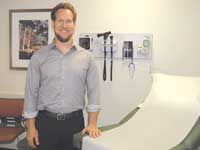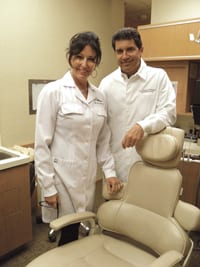Shouldering Responsibility Preventive Measures Can Reduce Incidence of Rotator-cuff Injuries
Dr. Jonathan Fallon sees many people with rotator-cuff injuries. The rotator cuff is part of the shoulder, and the majority of his patients with this problem are either young athletes or active, middle-aged adults who are playing a sport or performing work that requires overhead movement.
“I tell them, ‘the will to win is nothing without the will to train,’” said the chief of orthopedics at Cooley Dickinson Hospital.
But the training he talks about is not related to practice sessions. Instead, it is dependent on preconditioning.
“People need to learn how to strengthen the muscles around their shoulders. Most injuries can be prevented with some very simple and directed exercises,” Fallon said, adding that the topic is timely because people of all ages make plans to play summer sports, such as baseball, volleyball, and tennis. Adults will jump out and play tennis or softball after being indoors all winter, and even active laborers are susceptible to injury.
Dr. Darius Greenbacher agrees. “Activities like throwing are hard on the shoulders, and in order to stay healthy, it’s important to engage in preseason preparation and monitor the shoulders from day to day, allowing time for rest,” said the medical director of Baystate Medical Practice Sports and Exercise Medicine.
“Shoulder health is an issue that can and does affect anyone and everyone,” he went on. “It’s not just a problem for athletes. Ideally, all of us should listen to our bodies and move slowly into new activities by working on strength, flexibility, posture,nd endurance so we don’t become injured.”
But that’s something most adults fail to do, and the importance of this type of exercise is not usually communicated to young athletes and their parents.
“The danger is that a lot of kids are coached by volunteers who are willing, but not necessarily well-trained,” Fallon said. “The kids learn how to play sports, but don’t learn how to take care of their bodies or why it’s important, so they experience injuries that include muscle tightness, and, more importantly, muscle imbalance. For example, the shoulders of volleyball players who constantly spike balls over their heads can become like an unbalanced wheel.”
Greenbacher concurred. “We are seeing more and more of these injuries in young athletes,” he said, adding that he has treated 12-year-old baseball players. “Although overuse is traditionally an adult problem, many young people today are playing the same sport year-round. In the past, young people played two to four sports, which stressed different parts of the body, and other muscles had time to heal.”
In addition, the anatomy and activity level of children and teens differs from adults. “Their bones are still growing, so their muscles and tendons are playing catch-up with their skeletal structure, which means they have less stability in their joints,” Greenbacher said. “But the fact that they are always moving and/or playing keeps their bodies more flexible.”
Still, experts are concerned that young athletes are often pushed too hard, too early.
“They are not given enough time to build the strength and stability they need to keep their bodies safe from injury, and teenage boys are often told to be tough, that pain is part of playing a sport, and they need to push through it,” Greenbacher continued.

Fallon encourages young people to participate in as many sports as they can. “Overspecializing leads to an imbalance in muscles,” he said, adding that adults who experience pain are usually wise enough to stop doing things that hurt. “The older population understands that pain is protective, and for the most part they avoid it, especially in elective activities,” he said. “But people of all ages still need to learn how to maintain their bodies.”
Repetitive Stress
The rotator cuff is made up of four muscles and associated tendons that run over the top of the shoulder joint. The tendons stabilize the joint while the shoulder is being moved by surrounding muscles.”
“The muscles are not large — their purpose is to control rotation of the ball in the ball-and-socket joint, and they all have to work together perfectly to maintain it,” Fallon said. “If one muscle doesn’t work well, it causes irritation and inflammation, and the rotator cuff becomes like a wheel that is out of round.”
Rotator-cuff injury is sometimes referred to as rotator-cuff disease or impingement syndrome, but Fallon said it is actually more of a tendinitis issue than a mechanical one, and those terms are outdated. “Our understanding of the rotator cuff has evolved over the past 40 years,” he told HCN.
Greenbacher said everyone experiences an aching shoulder at one time or another, but it’s important to pay attention to one’s body and seek help if the pain doesn’t resolve within a few days or a week, or if it causes someone to change the way they move.
“A lot of adults whose shoulders are still sore the weekend after playing a sport like baseball will play again and ignore the pain, but inconsequential injuries can build up,” he warned, adding that the risk of damage increases with age due to degeneration of the tendons.
Greenbacher likened the tendons to a rope, and said micro-tears can cause the tendons to become frayed over time, like the strands of a rope would. “Rotator-cuff injuries are also under-recognized in industrial athletes, such as carpenters, who become so used to having aching shoulders, knees, and elbows that they often don’t seek treatment.”
The first sign of trouble is pain toward the front of the shoulder, vague pain, or fatigue during play.
“If there is an imbalance in the muscles, force is dispersed to different parts of the body,” Fallon said, referring to overhead movement. “People may notice pain in their elbow or forearm, and elbow pain is a very good indicator that the person has a shoulder problem.”
However, lack of pain does not mean the rotator cuff is healthy. “It is certainly not the only indicator of injury,” he said, explaining that weakness can be uncovered when a doctor asks a patient to perform specific movements, such as bringing their arm to the side or rotating it in or out. If they are unable to do it easily, it can be a sign that there is a problem.
“The body will increasingly accommodate for minor weaknesses in the rotator cuff,” he went on, “which is why pain is not necessarily a good indicator of shoulder health.”
Exercise Regimen
Once an injury has occurred, it is necessary for athletes to take a break from their sport, because the most important element in healing rotator-cuff injuries that don’t require surgery is time.
“The shoulder needs to rest,” said Greenbacher. “People can do some simple stretching when the pain stops, and there are times when using an anti-inflammatory can help with discomfort, but rest and recovery are key.”
The reason is that rest allows pain and inflammation to subside. “After that, the muscle imbalance can be addressed,” Fallon said, adding that a group of exercises called the ‘throwers 10’ is the primary prescription he uses for rotator-cuff problems. “Rotator-cuff injuries are frequently treated with specific exercises, which are almost universally the first treatment doctors prescribe. If that fails, then the doctor will proceed with advanced imaging, such as ultrasound, and/or surgery.”
The only equipment people need to do the throwers 10 exercise regimen is a set of elastic bands that can be purchased at a sporting-goods store. Fallon said instruction on how to do the exercises is available at www.hampshireorthopedics.
“However, we strongly encourage people to sit down with an athletic trainer or physical therapist and go through them,” he advised, adding that resumption of the sport or activity which caused the injury should be done very slowly and deliberately.
“But, fortunately, the rotator cuff responds very predictably to that set of exercises, even in the older population,” he said, citing a study conducted in Great Britain of people with rotator-cuff injuries. “Eighty-five percent of the people who did the throwers 10 exercises didn’t require surgery, and 85{06cf2b9696b159f874511d23dbc893eb1ac83014175ed30550cfff22781411e5} who did not do them required surgery.”
In addition to repetitive stress, the rotator cuff can also be injured during a traumatic event. “Traumatic injuries can occur at any age,” Greenbacher said, citing examples such as falling on ice or on an outstretched arm. “The muscles can be stretched to the point where they tear, and the injuries can also include broken bones and tears of the ligament.”
Traumatic injuries are very painful, and people typically go to a hospital emergency room or urgent-care center after sustaining them, where magnetic-resonance imaging can show if there are tears in the muscles, tendons, or ligaments. “Significant tears have to be repaired surgically,” Greenbacher said.
The amount of time it takes to recover from a rotator-cuff injury depends on a person’s health and age. Tendinitis or muscle strain can take up to four or five months to heal, depending on the severity or underlying muscle imbalance. But Greenbacher said people who work with a physical therapist are usually back to normal within four to eight weeks.
However, surgical repair entails a longer recovery. Fallon it takes about six months for a person to regain 85{06cf2b9696b159f874511d23dbc893eb1ac83014175ed30550cfff22781411e5} of their strength after surgery and about a year to regain 100{06cf2b9696b159f874511d23dbc893eb1ac83014175ed30550cfff22781411e5}.
Moving Forward
Fallon said exercise is critically important in preventing rotator-cuff injuries, as well as helping them to heal.
“Once an exercise regimen is started, the exercises should be done three to four times a week,” he said in conclusion. “They don’t take much time and are a small investment to make to maintain the health of the shoulder. Your shoulders are a tool, and parents whose kids play sports need to understand the importance of appropriate stretching and strengthening of the shoulder muscles.”
In other words, good health for this important part of the body requires people to shoulder responsibility.




Comments are closed.